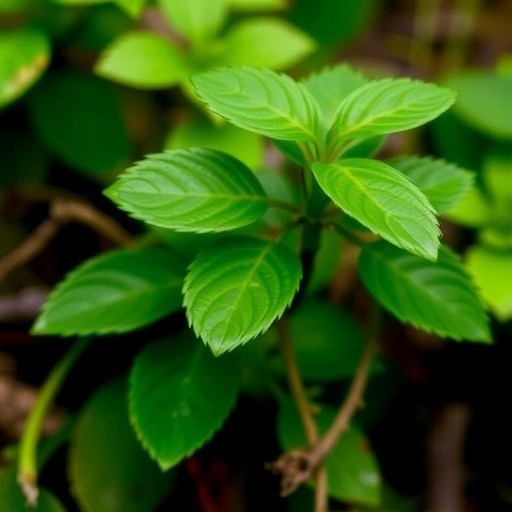Recent advancements in genomic research have brought forth significant insights into the complex taxonomy and evolutionary history of various plant species. In a groundbreaking study led by Hu, Wang, and Xu, the researchers delve into the intricate world of the Chloroplast genome, focusing specifically on the genus Polygonatum, a member of the Asparagaceae family. Their comparative analysis aims not only to assess the genetic makeup of these plants, but also to provide a valuable framework for the development of molecular markers in traditional medicinal plants. The findings of this study, soon to be published in BMC Genomics, hold important implications for both botanists and herbal medicine practitioners globally.
One of the primary objectives of this research was to explore the genetic diversity present within the Chloroplast genomes of Polygonatum species. The Chloroplast genome is a vital component of plant genetics, playing a key role in photosynthesis and livelihood. Given its critical functions, understanding the variations within these genomes can shed light on the evolutionary adaptations that different species have undergone over time. By sequencing the Chloroplast genomes of multiple Polygonatum species, the researchers created a comprehensive database that highlights phylogenetic relationships and key genetic markers.
In their comparative analysis, the authors employed advanced genomic technologies, including next-generation sequencing (NGS), which allows for the rapid and efficient sequencing of large amounts of DNA. This state-of-the-art technique enables researchers to decode the complex genetic sequences within Chloroplast genomes accurately, facilitating detailed comparison among species. The use of NGS not only increases accuracy but also significantly reduces time and costs associated with traditional sequencing methods.
Furthermore, the researchers performed a thorough phylogenetic analysis, reconstructing the evolutionary history of the Polygonatum genus. By utilizing genomic data, they were able to establish clear lineage distinctions between different species, leading to a reassessment of the taxonomic classifications previously held. This reassessment is critical, as accurate taxonomy is essential for understanding plant relationships and distributions, which can impact conservation strategies and agricultural practices.
As an integral part of their study, Hu and colleagues also investigated the potential of developing molecular markers derived from the Chloroplast genomes of Polygonatum species. Molecular markers serve as invaluable tools in plant research, particularly in identifying species, assessing genetic diversity, and understanding gene flow within populations. The development of specific markers from medicinal plants is especially important, as these markers can facilitate breeding programs aimed at increasing the effectiveness of herbal remedies.
The implications of this research extend beyond academic curiosity; they have practical applications in traditional medicine. As the understanding of genetic markers improves, it may lead to more reliable cultivation of medicinal plants, ultimately enhancing the quality and efficacy of herbal products. By ensuring that these plants are accurately identified and preserved, practitioners can provide better therapeutic options to users, rooted in a deeper understanding of each species’ unique properties.
In addition to their contributions to the field of taxonomy and genetic research, the findings from this study may also stimulate further exploration into other genera within the Asparagaceae family. As research continues to unfold in the realms of plant genetics, more complex relationships among species and their respective Chloroplast genomes may come to light, revealing behavior previously obscured by taxonomy alone.
This study’s comprehensive approach underscores a growing trend in botanical research that emphasizes interdisciplinary collaboration—the merging of genomic science with traditional botanical studies. Such interdisciplinary approaches not only enrich knowledge but also hone practical methodologies for utilizing traditional knowledge alongside modern scientific inquiry.
As the world continues to grapple with the impacts of climate change and biodiversity loss, research like this also plays a critical role in conservation efforts. A deeper understanding of plant lineage, adaptations, and genetic diversity equips conservationists with the tools necessary to protect endangered species and maintain biodiversity in a rapidly changing environment.
Overall, the work conducted by Hu, Wang, and Xu represents a significant milestone in the ongoing exploration of plant genomes. Its potential impact ranges from enhancing the efficacy of traditional medicine to contributing to broader biodiversity conservation efforts. The complexity of plant genetics and the promise of molecular markers elicit excitement in the scientific community and should captivate anyone with a passion for understanding the intricate connections between plants and medicine.
The full ramifications of this research will continue to unfold as more practitioners and researchers engage with the findings. The collective efforts in mapping the chloroplast genomes of traditional medicinal plants like Polygonatum will pave the way for advancements in both science and healing practices. As future studies build upon these findings, we anticipate a resurgence in the integration of traditional knowledge with contemporary science, producing a harmonious blend that honors both the past and the future.
The potential for molecular marker development sparked by these findings is vast, and as such, it opens the door for future studies targeting not only Polygonatum but also other genera within the Asparagaceae family. By continuing to expand our genetic understanding of these plants, researchers can forge pathways for sustainable practices that preserve both biodiversity and traditional medicine.
As a closing note, the research serves as a reminder of the intricate web of life that connects all species and emphasizes the necessity of safeguarding our natural heritage through informed science and collaborative effort. This ongoing journey combines the foundational work of botanists, geneticists, and traditional medicinal practitioners, leading toward a comprehensive understanding of plant biology that benefits both science and society.
Subject of Research: Chloroplast genome comparison and taxonomic reassessment of Polygonatum.
Article Title: Chloroplast genome comparison and taxonomic reassessment of Polygonatum sensu Lato (Asparagaceae): implications for molecular marker development in traditional medicinal plants.
Article References:
Hu, Y., Wang, S., Xu, Z. et al. Chloroplast genome comparison and taxonomic reassessment of Polygonatum sensu Lato (Asparagaceae): implications for molecular marker development in traditional medicinal plants.
BMC Genomics 26, 796 (2025). https://doi.org/10.1186/s12864-025-12012-y
Image Credits: AI Generated
DOI:
Keywords: Chloroplast genome, Polygonatum, molecular markers, taxonomic reassessment, traditional medicinal plants.




